Fee fi fo fum…
Hill giants are your iconic and classic “big dumb giant” who terrorizes the local countryside.
These primitive mindless brutes live to eat and their raids commonly spell BIG problems for local settlements.
Hill Giants have an animal-like society if it can be called a society at all. The biggest, meanest, and scariest of the bunch becomes the chieftain of the tribe.
Driven by simple, gluttonous desires, these giants are the lowest rung within the giant’s ordning. That means that, among the evil giants, they are far lesser threats than both Frost and Fire Giants.
Hill Giants come in handy for any low or mid-level campaign. At higher levels, these chaotic evil brutes are often the minions of more powerful creatures such as dragons.
The great thing about the Hill Giant is they fit into almost any campaign and any environment with little to no fuss!
Ready to go giant hunting?
Well, tighten up your armor and let’s take a closer look at these classic foes in our Guide to Hill Giants in D&D 5e.
What Are Hill Giants in D&D 5e?
When it comes to the ordning (which is the social structure and hierarchy of the Giants), Hill Giants are at the bottom of the ranking. Though they don’t particularly seem to mind.
Hill Giants are basically big bully oafs with the brain power of mashed potatoes. While they are not respected for their wits, their hulking muscles and raw aggression more than make up for that lack of respect.
These big bullies are primitive eating machines that reside in crudely built steadings and huts spread throughout the hills, mountains, and valleys of the world. They especially enjoy setting up where there are nearby villages and settlements with plenty of livestock to feast on.
These tribes are each led by a chieftain who is the strongest and scariest of all the other Hill Giants.
Hill Giants are not known for their intellect and, as such, they don’t have many pastimes other than eating and raiding. They don’t have the ambitions and organization of their Fire Giant cousins. Nor do they have the crafting skill of Stone Giants or the hunting drive of Frost Giants.
Because of their brutish behavior, Hill Giants certainly aren’t welcomed in Cloud Giant society. Unless I suppose, there’s a kind of “Dinner For Schmucks” situation at hand where each Cloud Giant tries to bring the stupidest guest they can to a party.
Actually, that could be pretty fun… But moving on!
Hill Giants appear in the 5e Monster Manual. They also appear prominently in the Storm King’s Thunder adventure as well as the 5e version of the classic “Against the Giants” adventure which is found in the Tales From the Yawning Portal.
Appearance
A Hill Giant’s skin is tanned from a life spent trudging up and down mountainous hills and napping in the sun. This time in the sun has also toughened their hide providing them with a natural armor of sorts.
Their weapons of choice are uprooted trees and rocks dug out of the ground. It’s rare that you’ll find a Hill Giant without one!
To the surprise of literally no one, Hill Giants’ hygiene leaves a lot to be desired. Their sweat adds to the stench of the rough animal skins they wear, which are badly patched together with hair and leather bindings.
Hill Giants average around 16 feet in height and have large muscular builds often with large pot bellies. They are massive brutes that easily dwarf their prey.
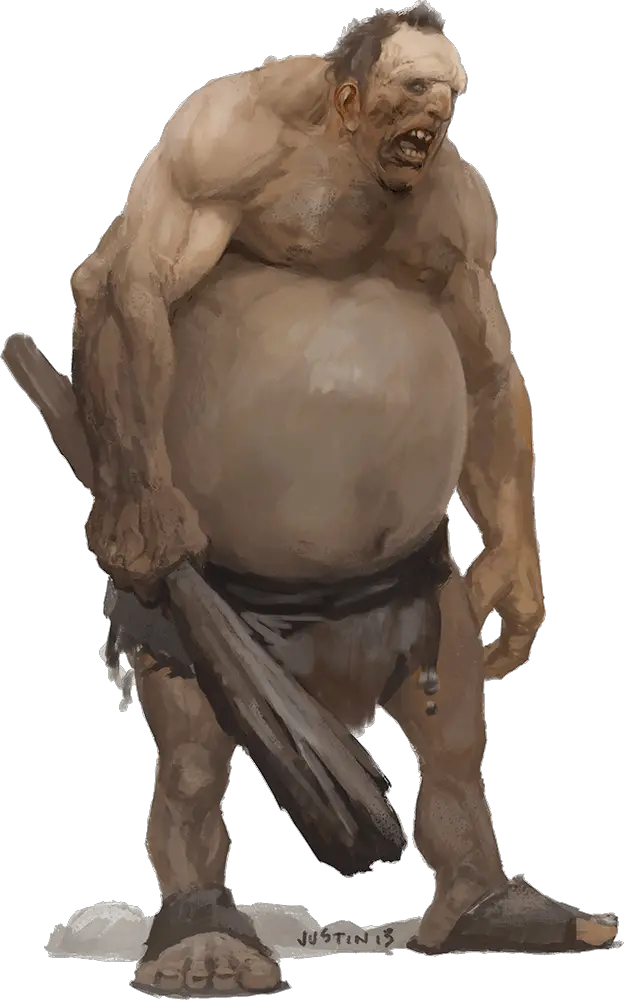
Hill Giant Abilities
As one would expect, Hill Giants are extremely strong and durable like their cousins. However, they lack grace and are commonly very clumsy and slow-moving.
Hill Giants are not known for their intelligence or planning and are downright dimwitted. This means that a Hill Giant is often easy to outwit and many players will take advantage of these lumbering goons and their complete lack of brain power.
They also lack any true charisma or leadership qualities other than bullying smaller creatures in hopes of attaining power.
STR 21 (+5) DEX 8 (-1) CON 19 (+4) INT 5 (-3) WIS 9 (-1) CHA 6 (-2)
Hill Giants have some definite weaknesses, the biggest being their Armor Class of 13 (natural armor) which is due to their tough hides and the furs they wear. Their Dexterity and Wisdom saving throws can also be considered major weaknesses as they are two of the most common saving throws in D&D 5e.
But Hill Giants are a resilient bunch that can really take a ton of damage. They average 105 hit points as a CR 5 monster which is quite impressive.
The only real bonus that a Hill Giant receives when it comes to skills is a +2 on Perception checks.
One last benefit a Hill Giant possesses is its 40 ft. speed. They might lack motivation, but their large size still means that they can cover a lot of ground. Escaping these lumbering hulks (especially if one thinks you look extra tasty) is going to be a challenge!
A Hill Giant is more than capable in combat situations with a +8 to hit whether it be their greatclub melee weapon attack or their rock-hurling ranged weapon attack.
Dishing out a whopping 3d8+5 damage per hit with their greatclub, a Hill Giant also packs quite a punch when it lands a blow.
But that’s not all!
Like their giant cousins, Hill Giants benefit from the multiattack Action. That means it can attack two times with its greatclub which also has a reach of 10 feet.
This can quickly have most mid-level parties saying “OUCH”!
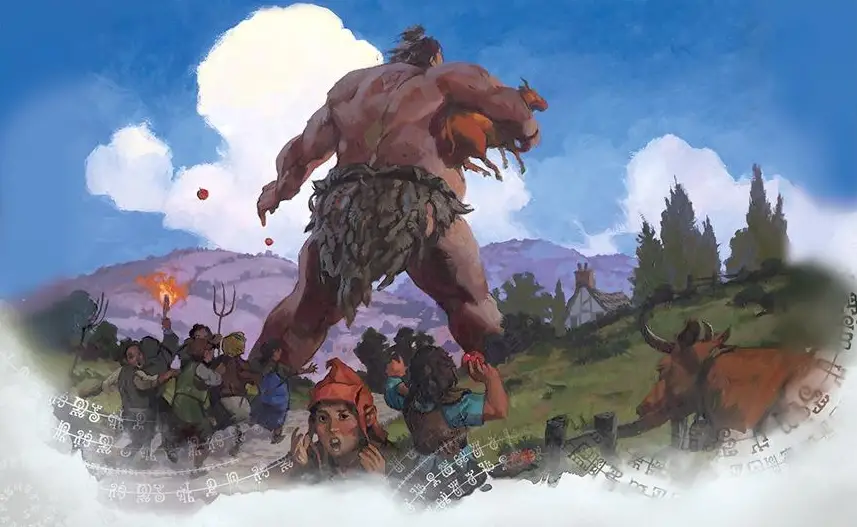
Primitive Goons
As their name implies, Hill Giants most commonly inhabit hills and mountain valleys. Their housing is usually a steading or a group of huts loosely constructed of wattle and mud.
These steadings and huts are usually well-defended and within areas that allow them to raid nearby humanoid settlements. After all, why bother walking farther than you have to to get a meal?
Villages and settlements live in fear when a tribe of Hill Giants sets up nearby. At that point, it’s only a matter of time before all of the settlement’s livestock, crops, and even people are devoured by the gluttonous Hill Giants!
It’s also virtually impossible to reason with Hill Giants. They lack any morals and are chaotic evil gluttons who will always desire more food no matter how much havoc they have to wreak to get it.
Size Equals Power
Hill Giants are bullies who see humanoids and livestock as easy prey while they view larger creatures as more powerful. Being so dimwitted that they associate size with power oftentimes leads to their own detriment.
In fact, Hill Giants are so dense that they do not even realize what the ordning is or that they are part of it. For a Hill Giant, it’s simple: other giants are bigger and stronger so they need to be obeyed.
This same concept applies to the Hill Giant den itself.
The tribe’s chief is usually the biggest of the bunch and not necessarily the most cunning. Of course, this is all relative considering that Hill Giants can barely outwit a stick in the mud.
Though they can definitely smash it…
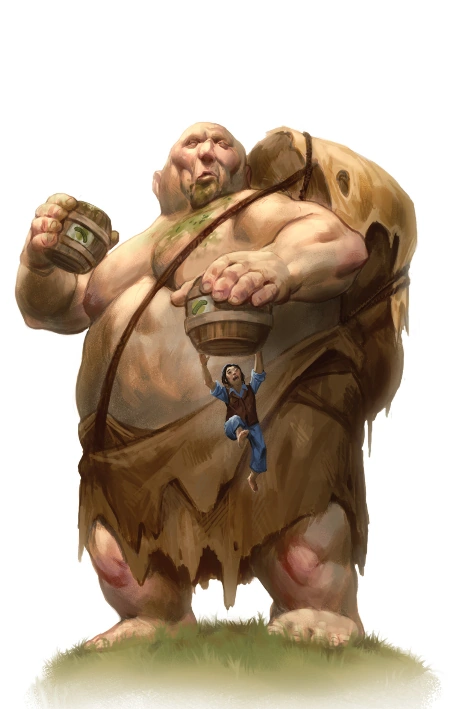
Unending Appetites
As we previously mentioned, eating is the thing that most Hill Giants love more than anything else in the world.
In fact, many Hill Giants will hunt on their own so as not to have to share with the rest of their tribe. These solo hunters often take out a dire wolf or brown bear companion to assist them.
A Hill Giant’s gluttony is a terrifyingly real thing. It cannot be stated enough that expecting these giants to understand sharing and teamwork is a lost cause. This is why you won’t see more than two Hill Giants hunting together except in extraordinarily rare instances.
The typical Hill Giant’s diet consists of anything that is even remotely edible.
They avoid poisoned foods but often don’t have the mental capacity to know if something is poisoned. They prefer livestock, game, and humanoids but will also often eat rotten meat, plants, and even mud if they get hungry enough.
However, due to their size and gluttony, they like to eat A LOT. This means that they are often out on raids as the promise of food is one of the few surefire ways to motivate a gang of Hill Giants.
There are many pests (both magical and mundane) that a farmer fears, but perhaps none are so feared as a Hill Giant.
Hill Giants are known to eat entire herds of livestock such as cows, sheep, chickens, and even goats. After they’ve decimated the herd they’ll move on to the crops and even the farmer himself.
“Stuff-Stuff”
Hill giants have been known to occupy themselves with inane activities, usually involving food or eating in some form.
In one such game, known as “stuff-stuff,” the Hill Giants attempt to stuff as many little creatures into their mouths as possible simultaneously without swallowing.
Only Hill Giants could invent such a “game.”
Smaller characters such as dwarves, gnomes, halflings, kobolds, and goblins should be especially careful if they don’t want to find themselves involved in a game of “stuff-stuff.”
Stupid But Deadly (SBD)
The ability to digest almost anything has done well for the Hill Giant. In fact, their iron stomachs are a large reason why they’ve never needed to adapt their way of life.
However, the lack of need to adapt as well as their remarkably low intelligence means that Hill Giants have never really developed their own culture. Well, at least beyond doing a lot of raiding and eating.
Curiously enough, this lack of culture has caused Hill Giants to imitate the traditions of other creatures, especially their fellow giant kin. However, sometimes they observe and learn from non-giants, such as dwarves or elves which often leads to comical results.
You might stumble upon a Hill Giant (or possibly a group of them) that has begun imitating (likely very poorly) the rituals of Elven Druids. Maybe they’ve made some… interesting… headdresses or other such wardrobe decisions.
Learning some basic concepts of commerce from Dwarven merchants, some Hill Giants might develop some bizarre form of barter system.
For better or worse, Hill Giants are almost painfully blunt and direct in their communications. This means that they have no real concept of lying or other manipulative forms of deception.
Because deception is simply beyond their mental facilities, this also makes them easy to trick and manipulate. Clever adventurers disguising themselves as another giant has caused many a Hill Giant to flee in fear!
One thing is for certain, reasoning with these oafs is useless and considered a waste of time even among their fellow giant kind.
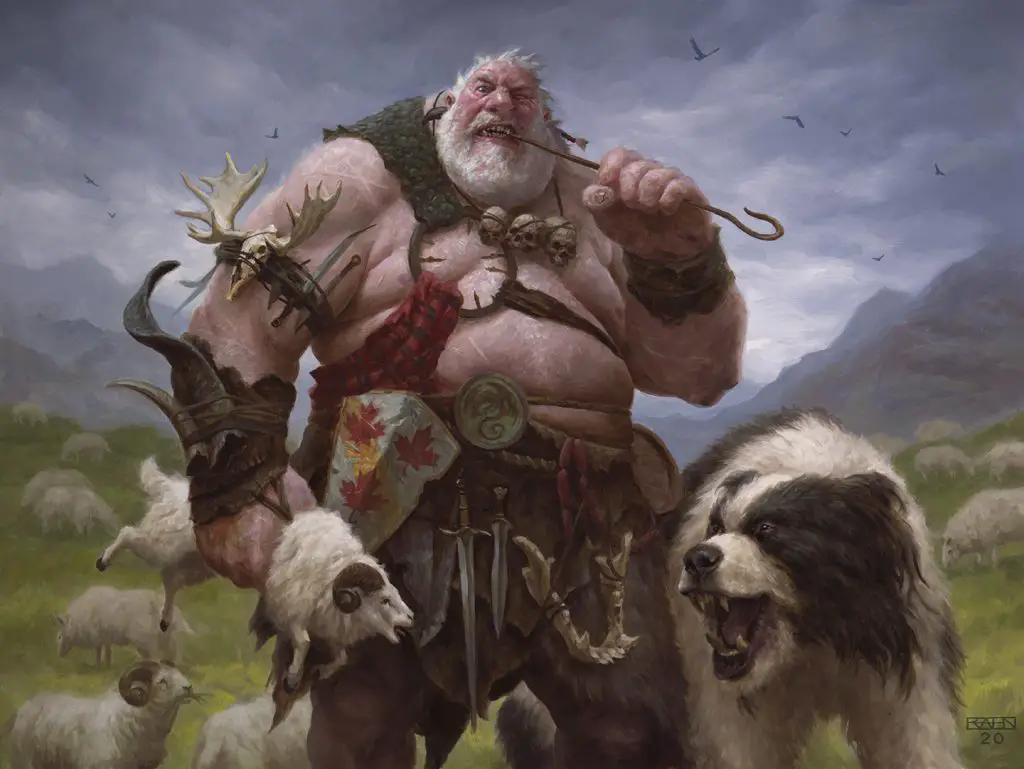
Encountering a Hill Giant
Encountering a Hill Giant at lower to mid-levels is a fine example of what Dungeons and Dragons is all about. They make for excellent and classic enemies that can be easily included in virtually any campaign.
Not to mention, level 5 is when most classes are getting major power-ups and is often considered to be the golden tier of play. As a CR 5 enemy, Hill Giants make for excellent tests for these parties!
At higher levels, Hill Giants tend to be the minions of some greater and more powerful evil. Hill Giants themselves often team up with dire wolves and bears when out on a raid.
Ogres, orcs, and goblins may also be allied with Hill Giants. Oftentimes, dwarves, elves, and other humanoids are used as slave workers as well as meals.
Hill Giants are bad news for any neighboring settlements and are sure to be a thorn in their side. Adventurers will be needed to save these settlements from the constant chaos and damage Hill Giants can do in more civilized lands.
Encountering Hill Giants in their den is also not for the meek of heart. Doing so will require not only strength and grit but also planning and even deception.
Running Hill Giants as a DM
Hill Giant LIKES SMASH!
A Hill Giant should have little trouble getting into melee range with their 40 feet of movement per turn. If they are unable to approach the PCs, they can pick up a rock and throw it 60-240 feet away. However, this should only be utilized as a last option.
The greatclub multiattack is a devastating offensive combo that is too good to pass up. Rest assured, the Hill Giant has the means to get in range and make it work in most situations.
We’re getting ahead of ourselves here though…
As a DM, you want to keep in mind these brutes have Intelligence scores of 5. Any real strategy is way out of their job scope. However, even these dumb giants know they enjoy smashing things much more than they do hitting them with rocks.
Hill giants will almost always rush into combat so they can get to smashing the puny PCs. Nothing compares to the smile on a Hill Giant’s face as it smashes anything and everything it can with its greatclub.
At the end of the day, Hill Giants will have one goal: to smash their opponents until all that’s left is a deep crater in the ground.
It’s the little things in life, ain’t it?
Encountering Hill Giants as a Player
Battling Hill Giants at lower to mid-levels can be a pretty exciting challenge. With Hill Giants being such classic and iconic enemies, such encounters are almost a rite of passage!
For those who enjoy some clever roleplaying and manipulation, using their lack of intelligence against them can be great fun. Though much of that relies on your own quick thinking in the situation you find yourself in.
However, for the party that prefers to take Hill Giants on in combat, we have some useful tips for you. These should keep you from getting smashed into jelly!
Hill Giants lack good Dexterity and Wisdom saving throws. Spells and effects that target prompt these saves tend to be pretty devastating, so don’t hesitate to use them. The odds are certainly in your favor!
Additionally, Hill Giants have a low armor class of just 13 and instead rely on a large pool of hit points. However, they’re easy to hit which means that you can potentially chew through those hit points pretty quickly.
Even taking a penalty to your attack roll with feats like Sharpshooter and Great Weapon Master to deal more damage is still a tactically wise decision. While you’re never truly guaranteed to hit, you almost certainly will.
Overall, ranged attackers will have a field day turning Hill Giants into big, angry pin-cushions.
Just make sure to avoid the Hill Giants rock hurling attacks when you’re at range! (Though those are still much more survivable than taking them on up close where their multiattack can do some serious damage.)
In a straightforward melee battle that’s up close and personal, it really comes down to attrition. Hill Giants are easy to hit but they also put out (and take) large amounts of damage as well!
If you do engage in melee combat with a Hill Giant, you’re pretty much locked in. With 40 feet of movement per turn, it can be hard to get away if one decides to chase you!
Conclusion – Hill Giants in D&D 5e
The Hill Giant is yet another iconic giant and adversary for your D&D 5e campaign. While not as challenging as Frost or Fire Giants, Hill Giants are still a very worthy foe for players to face off against.
These lumbering evil oafs can pack a real punch and even chase fleeing PCs down if they don’t clobber them with rocks first. Their complete lack of thought also makes for some fun role-playing at the game table.
They’re an excellent low to mid-level giant for practically any scenario. Plus, their lore is adaptable enough to operate in nearly any campaign.
If you enjoy giant-themed campaigns be sure to check out Against the Giants or Storms King’s Thunder. Against the Giants is a personal favorite and illustrates the societal hierarchies of the Hill, Frost, and Fire giants quite nicely.
This wraps up our guide on Hill Giants in 5e and we’d like to thank you all for reading and supporting us here at Tabletop Joab.
Want to be the first to know about all of the latest DM tips, player guides, book reviews, and more for D&D 5e? Sign up for the Tabletop Joab newsletter today using the form below!

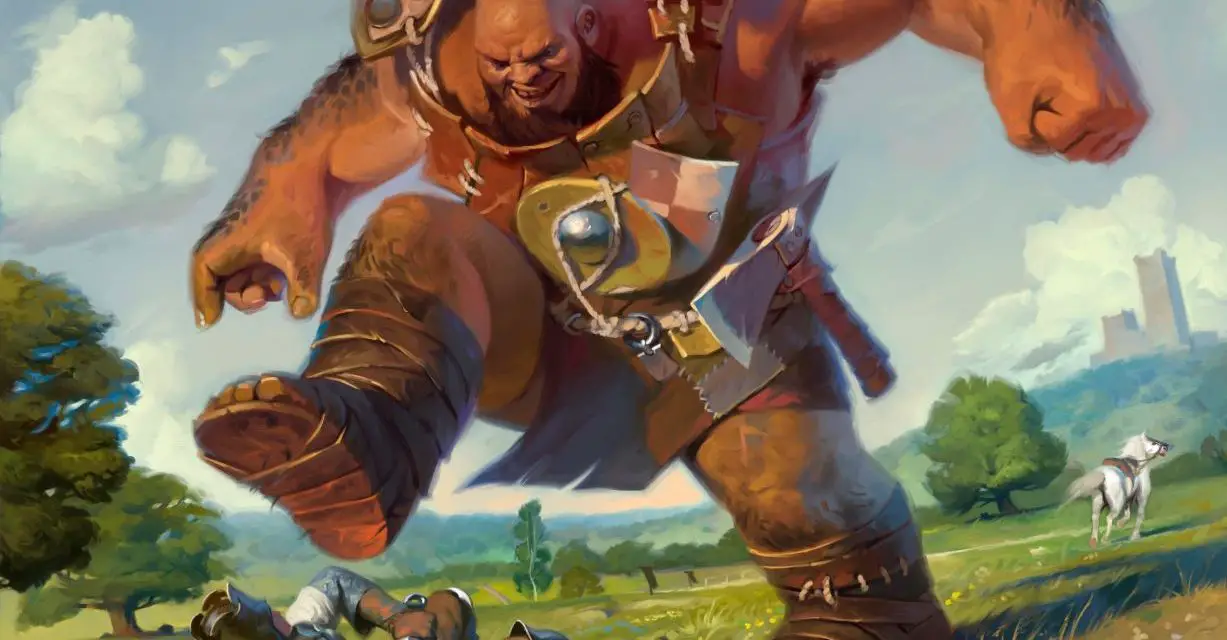

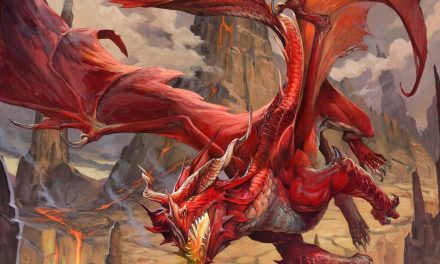
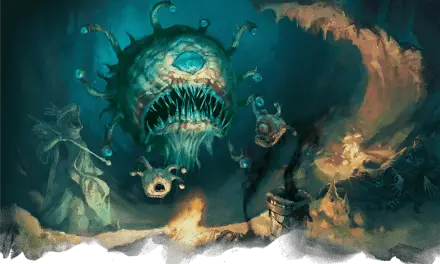
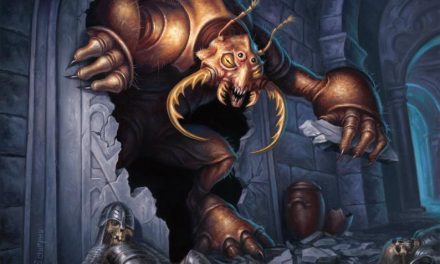
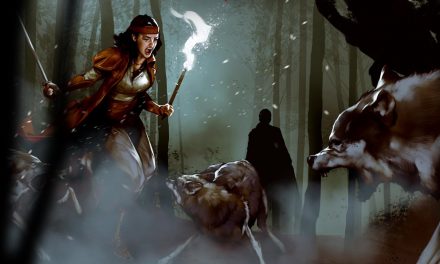




We met a Hill Giant in an Out of the Abyss campaign. It was stated that he suffers from a random madness, and we had a good laugh because our GM rolled the following: “I am the most handsome, the most clever and cunning around”.
Yes, a Hill Giant. Strange things lurk in the Underdark, indeed.
Hi V-Z!
That’s hilarious! It would be so hard to not laugh while roleplaying that character!
It reminds me of a Hill Giant NPC that I introduced my group to last year. He has become one of their favorites. I will save the details for now as I plan on writing an article about him sometime in the next few weeks! 🙂
Yeah, the GM was enjoying it. The players, myself included, were completely baffled and tried diplomacy and deception with the giant.
It failed.
The giant was too dumb to be deceived.